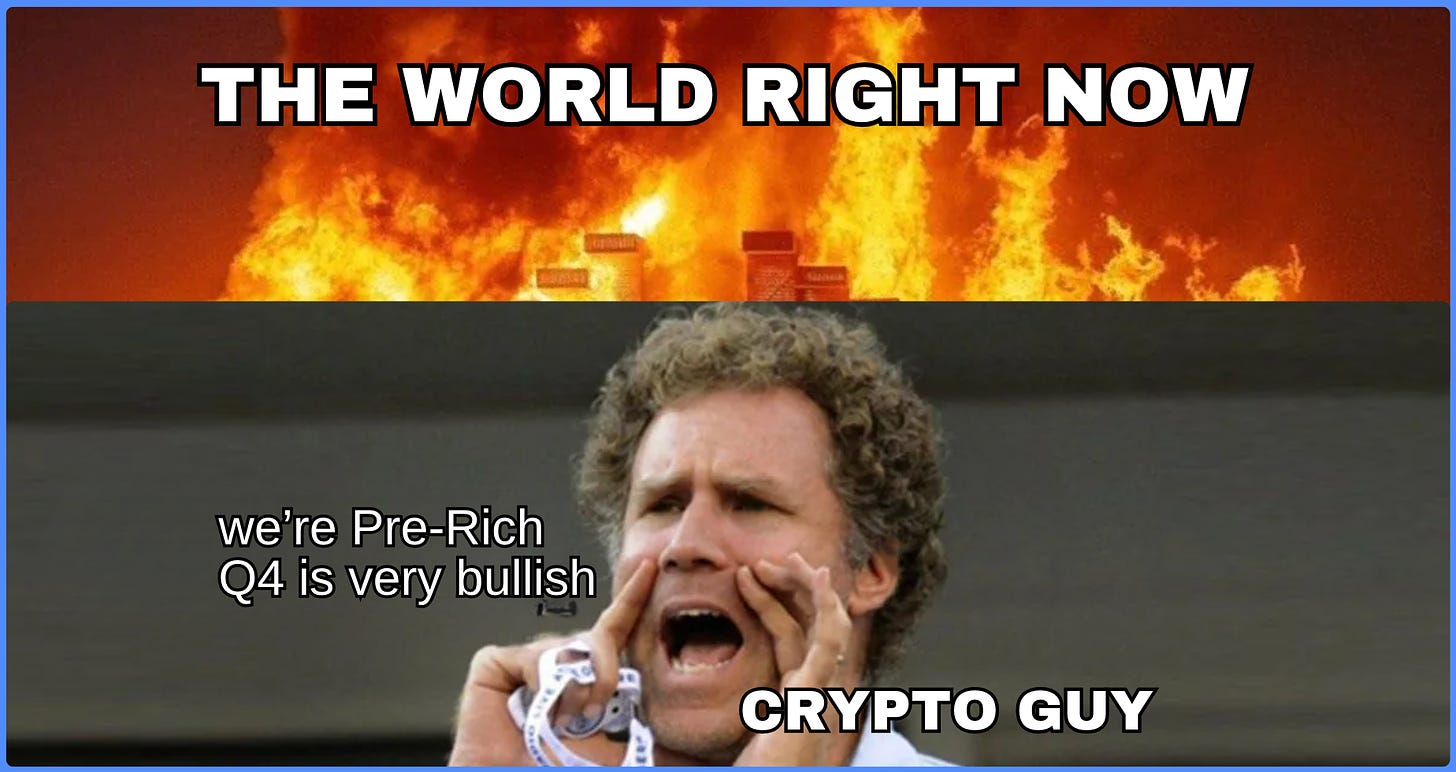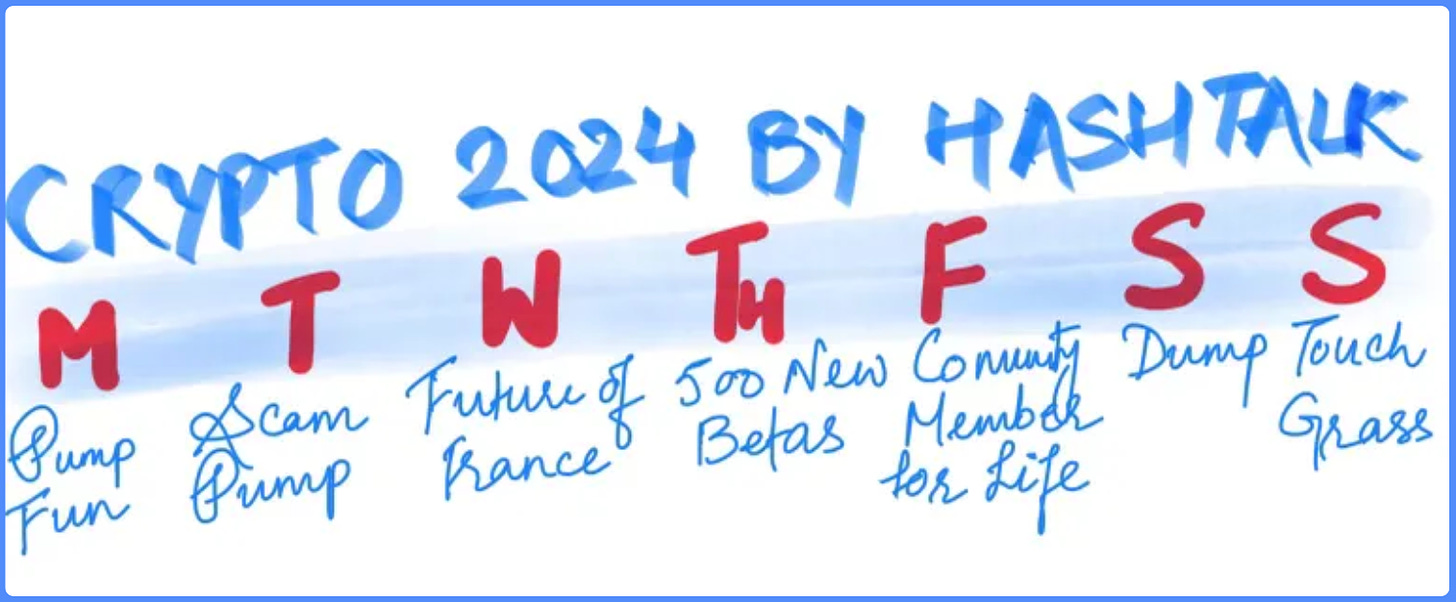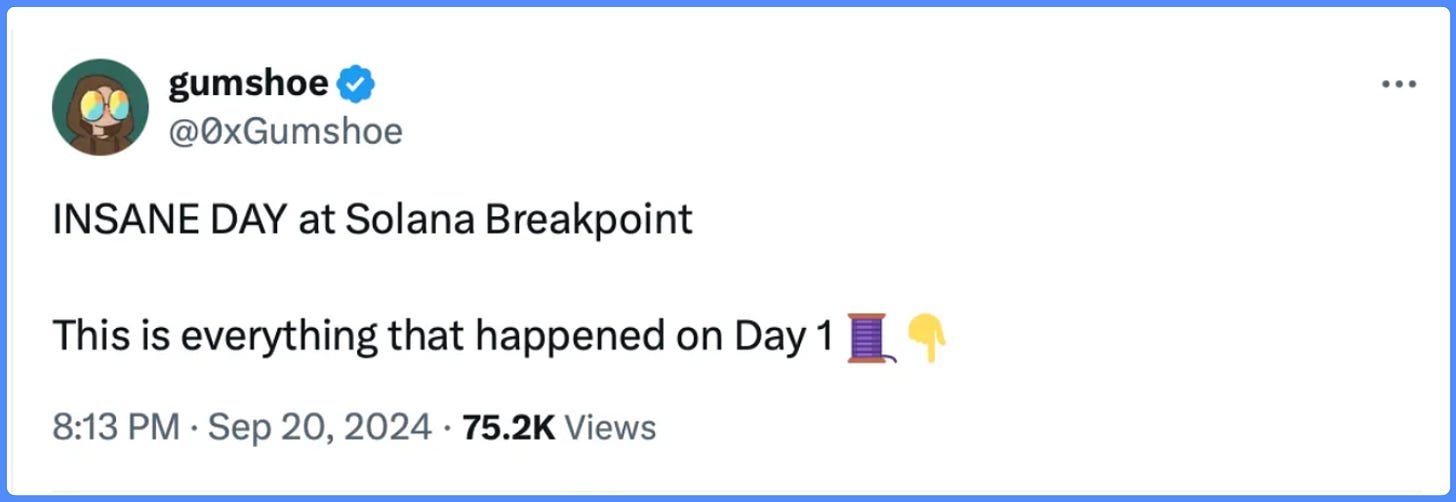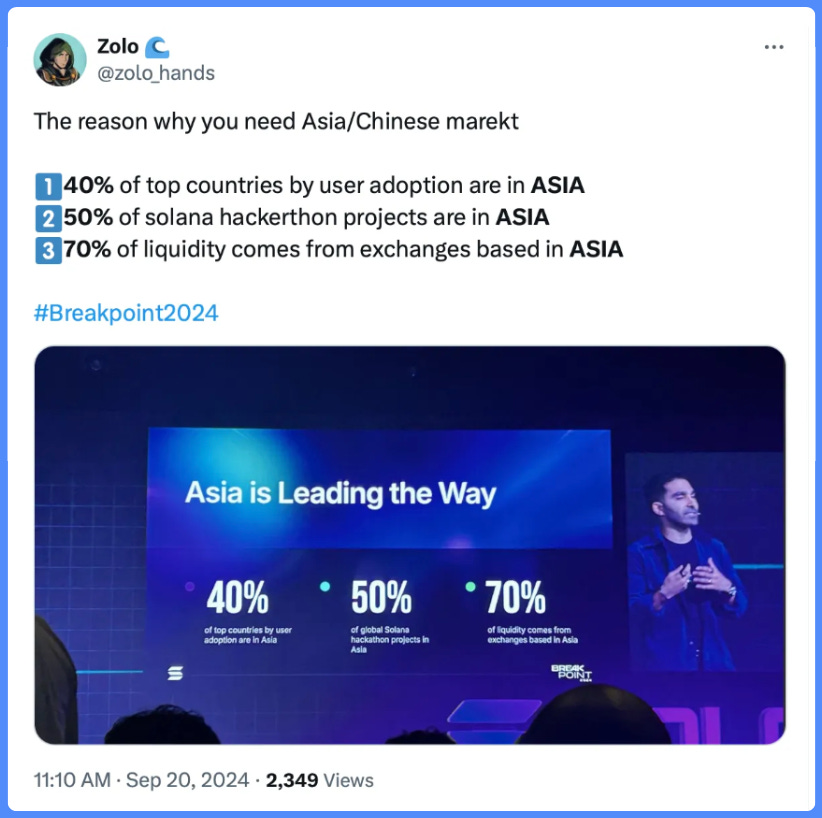Background Information
I spend a lot of time each week reading, researching, and engaging with some of the smartest founders and investors in the industry. This article is my attempt to present a very real snapshot of the state of cryptocurrency, as experienced by me at Token 2049 and Solana's Breakpoint. I have been active in this field since 2013, so please trust my judgment on the current situation. While most meetings were one-on-one, I also explored the maze of booths at Token 2049 like Alice in Wonderland.
First, let's applaud the organizers of Singapore, Marina Bay Sands, and Token 2049—the event was organized perfectly. Only Singapore could host such a high-level event in their busiest week, with the F1 weekend approaching.
Now, let's analyze the atmosphere, blockchain projects, founders, venture capital, narratives, and of course, the winners and losers of this event. Get ready, we're about to delve deep!
Overall Atmosphere

Over the past decade, we have been advocating the dream that cryptocurrency will completely change the world, solve real problems, and attract a large number of Web2 users into this new field. However, frankly speaking, cryptocurrency has not fully delivered on this promise. Instead, we seem to have collectively become adventurers seeking thrills, jumping from one Ponzi scheme to another, like squirrels on strong coffee.
The 500+ side events at Token 2049 are a typical example of this dilution. Excessive funding for many projects has led to marketing budgets exceeding actual revenue (if any), and the gorgeous booths and five-star venues mask the low user adoption reality. Venture capitalists who once poured huge sums into any project with a whitepaper have now hit the pause button. The good news is that now only truly promising projects can secure funding; the bad news is that it took us so long to get to this point.
As a result, we see a split in the market, with over 100 L1/L2 blockchains vying for the attention of the same group of crypto users—engagement is decreasing, and meaningful conversations are also diminishing. From Solana to Ethereum's memes, to Base, Justin Sun now flies too close to the sun like Icarus. While this is great for short-term dramatic effect, where is the long-term vision? Where is the mass adoption we are expecting? Jumping between different memes and blockchains is not a sustainable business model.
Over the years, we have transitioned from the ICO craze to DeFi yields, then to the NFT frenzy, GameFi Ponzi schemes, PoS staking and restaking plans, and now even Bitcoin restaking (is this real?), ultimately forming a pyramid of points and airdrops. What will be the next gimmick? People I've spoken to are deeply concerned about the future of this industry. Despite many things happening, the actual results are few and far between.
Venture capitalists are frustrated by their inability to foresee the frenzy around memecoins, as they cannot use regulated funds to enter this field. Founders complain that venture capitalists are no longer funding any project, hoping that one will stand out. Crypto adventurers are exhausted from jumping between different narratives, while "farmers" are disappointed that airdrops and points have not brought the expected wealth (e.g., Grass, Eigen, Blast, etc.). The only ones finding solace are those involved in trading (CEX, DEX, perpetual contracts), gambling (Rollbit, Shuffle, Polymarket, memecoins), and the infrastructure supporting these activities. This is evident from the F1 sponsorships, giant booths, and huge marketing budgets.
Meanwhile, AI and the stock market are attracting more attention, with NVIDIA's returns even rivaling those of cryptocurrency. In fact, NVIDIA's returns are higher, the risk is lower, and the user interface for fiat deposits is more straightforward and regulated. Smart traditional financial investors are profiting from lower-risk stocks (of course, I know stocks also have risks, but look at the current state of cryptocurrency). Since it's possible to gain exposure by buying options for MSTR or COIN, why bother investing in cryptocurrency?

Of course, things are not entirely bleak. There is still a glimmer of hope at the end of the tunnel. Some outstanding founders have received funding, and some real use cases with potential revenue are emerging. Venture capital firms are becoming more selective, which is a good thing. At the same time, we see more enterprises, such as Sony, global banks, and financial companies, cautiously entering this field. But let's be clear—this is still not the mass adoption we expect.
So where are the opportunities? I discuss this in the following sections, but I believe the answer lies in the perspective of each token holder. Your position, the game you're involved in, the group you belong to, and your situation will all affect your opportunities. In the cryptocurrency field, two types of games have emerged:
- Short-term narrative-driven—quick in and out— This approach is understandable, but mainly driven by adventurers, short-term founders, venture capitalists, and opinion leaders trying to bottom fish, hoping to get rich quickly.

- Long-term, projects supported by large venture capital funds, betting on top developers and founders, hoping to achieve huge returns through listing and potentially becoming the next Solana or infrastructure.
So, while the atmosphere of these activities may be somewhat gloomy, there are still some bright spots—founders, projects, and venture capital firms that may surprise us in the coming years. I have been in this cryptocurrency world for 11 years, and I will continue to persevere, but let me be clear: if Bitcoin reaches $100,000, we will quickly return to a situation similar to a Ponzi scheme. At that point, no one will care about the fundamentals—until the market rings the alarm, by which time it will be too late.
Stay hungry, stay foolish, stay hedged. — Sankalp Shangari, Hashtalk :)
Cryptocurrency Audience
- ### Cryptocurrency Speculators - (65%)
These newcomers are like enthusiastic puppies, chasing every shiny opportunity, mainly to catch the next Bonk, WIF, or Poppet and hoping to profit quickly and exit. Their characteristics include:
Optimistic speculators: They believe they can get rich overnight by quickly switching between different memecoins, like children trying different candies at a carnival.
Freebie enthusiasts: They are mainly interested in freebies—booth giveaways, parties, and countless events offering free drinks and snacks.
Short-sighted: Focused on immediate gains, they often overlook the bigger picture and the underlying complex game.
Project triers: Some even attempt to launch their own projects, usually relying on the support of like-minded short-term venture capitalists. However, most such founders struggle to gain long-term support.

- ### "Smart" Developers and Venture Capitalists (25%)
This group is composed of those glamorous, self-proclaimed elites who strive to emulate the success of Vitalik, Anatoly, or Raj, while pitching their dreams to the venture capital firms obligated to invest in them. Their strategies include:
Capital Priority: They ensure funding for the next 2-3 years, devise detailed plans, and create market hype through collaborations with key opinion leaders and flashy announcements.
Token Hedging: They often sell a large amount of tokens from their treasury to fund more operations and hedge these tokens at listing, planning to gradually sell them while driving the price down after they cash out.
Passing the Buck: If a bear market comes, venture capital firms and retail investors will be the last buyers, while these founders enjoy high salaries and business class travel.
Disguised Long-term Vision: They masquerade as advocates of change until the token is listed, at which point their true intentions are revealed—just like Blast and Friend.tech before jumping to the next Ponzi scheme. There are hundreds of such examples.
- ### True Builders (10%)
This final group is composed of true visionaries—those dedicated to building the "future of France" (or whatever future they envision) are the real "Chads." Their characteristics include:
Exceptional Minds: Not just selling dreams, these individuals focus on creating businesses that generate revenue and truly add value.
Persistence: Although they may struggle to gain attention in the early stages, they persist and do not issue tokens just to exit.
Long-term Commitment: They have a long-term perspective, are grounded, and are willing to realistically address issues, advocating for the sustainable development of the industry. In conclusion, these three groups demonstrate different attitudes in the cryptocurrency field—from impulsive speculators to savvy strategists, and finally to true builders who may lead us to a brighter future.
L1/L2 and Infrastructure
Ethereum's Identity Crisis: Ethereum is currently experiencing an identity crisis—like a midlife crisis, it wants to buy a sports car, while others are choosing electric cars. With a significant shift in attention and development resources towards Solana and some EVM Layer 2 solutions, many users are dissatisfied with Ethereum. Ultimately, price is more important than block size. I can't help but wonder if Ethereum's thought leaders are too comfortable in their mansions to interact with the grassroots developer community? Why can't they be like Solana? Is Vitalik really the right leader?
Solana: A Deserving Leader: In my view, Solana is like a confident winner of the "Best Performance Award" on stage. I have been a strong supporter of Solana in our Telegram channel and various newsletters from Hashtalk. After the Breakpoint event, the Solana ecosystem is more vibrant than ever. They don't just talk the talk; their product delivery speed is as fast as pizza delivery on race night. Look at Firedancer. The Solana community is very organized, especially compared to the chaos at ETHGlobal events. Solana's single-chain focus and unified community give them an advantage—focus, my friends, is key!

TON: The use of TADA's ride-hailing service and TON encrypted payments at the Token 2049 conference was a major highlight. Almost everyone was using it and sharing TON and TADA referral codes, which is a brilliant marketing strategy. With its internal user base of 800 million, TON is becoming a strong competitor in the L1 space and is poised for true mass adoption. I am very bullish on this.
Venture Capital and Funding the Next SOL Killer: Venture capital continues to flow towards projects that could potentially replace Ethereum or Solana. From an investment perspective, this is obvious: supporting a project that could bring 1000x returns in the next few years is like finding a golden ticket in a chocolate bar. Currently, there are over 10 L1 projects with almost no activity, yet they are trading at fully diluted valuations of $10 billion to $100 billion. This is a huge return for any venture capitalist. Keep funding until it works.
Layer 1 Hot Projects for Gen Z: Monad and Berachain are the current hot topics, while SUI and Base are also gaining attention. In contrast, "millennial" chains like Aptos, SEI, and TIA are losing momentum, and "baby boomer" chains like Polygon, Algorand, and Cosmos are quickly fading from view, faster than your New Year's resolutions. Of course, we will see brief price spikes driven by market manipulators and new narratives—such as FTM and AVAX—but these are often as fleeting as a Snapchat story. If I could find DApps on these chains that attract attention like GMX, Hperliquid, Polymarket, or Friend.tech, I might reconsider.
Chains Focused on Niche Areas: We are seeing a transformation of blockchain towards specific niche markets: Solana focuses on memes, payments, and trading, Ronin is dedicated to GameFi, and Arbitrum focuses on DeFi. This trend, combined with chain abstractions and cross-chain solutions, is improving the user experience, making interactions smoother.
Shift to B2B Infrastructure and Service Providers: Some well-known chains are offering CDKs, SDKs, rollups, and application chains. While this may help maintain their tokens' market position, it is more of a stopgap measure—suitable for living a luxurious yacht life, but not entirely sustainable for the long-term development of the entire ecosystem.
In conclusion, Ethereum is like a teenager hesitating about their hairstyle, experiencing an identity crisis, while Solana is rapidly advancing, actively promoting innovation and community interaction. As we continue to observe how this dynamic changes and which projects can truly stand the test of time, it will be very interesting.
Projects and Founders
The Harsh Reality of Crypto Financing: To be honest, most projects are slowly and painfully heading towards extinction in the crypto space. The glorious days of getting funding with just a dazzling PowerPoint presentation are over. Now, it's like trying to sell ice to Eskimos—good luck!
Funding Cycle: Endless Hamster Wheel: Even funded projects are not optimistic. They are caught in an endless cycle, rapidly consuming venture capital funds. Once the funds are depleted or close to exhaustion, they must either raise more funds or launch a token. If the token performs well, they might be able to hold on for another 2-3 years; otherwise, they have to start over. Without new users or actual revenue, the path to profitability is as blurry as driving on a desolate night road.
Rise of New Projects: Old projects are like once-popular but now forgotten toys. Why invest in outdated things when you can choose emerging projects like SUI, Aptos, Berachain, and Monad, which are attracting activity through grants? It's like old wine in a new bottle—and it might not even be the finest vintage.
Ponzi Scheme 2.0: Next are the Ponzi schemes that are popping up like mushrooms after the rain. This reminds me of the era of Celsius and BlockFi, when the lending market went out of control, leading to a staggering collapse. Now, we are seeing a similar cycle involving staking, restaking, and the classic "your token yields my token, and together we yield!"—but this time on a tenfold scale and expanded to ten times more chains. Where will it end? Unfortunately, no one can say for sure.
Dilemma of Technical Founders: Many technical founders seem optimistically oblivious to the peculiarities of cryptocurrency. They often fail to realize that token economics, product-market fit, and community building—popular buzzwords—are crucial for success. Success depends not only on a great product; you also need a large network and a bit of luck. If you don't belong to the right VC circle or "influencer alliance," then good luck to you.
In conclusion, cryptocurrency is a game of strategy, and if you want to participate, you must understand the rules of the game—otherwise, you might become another cautionary tale in the wild west of digital currency.
"They are playing a game. They are playing at not playing a game. If I show them I see they are, I shall break the rules and they will punish me. I must play their game, of not seeing I see the game." —R.D. Laing

Venture Capital
A Year for Venture Capital: Navigating the Crypto Quagmire: To be honest, most venture capitalists have had a tough year: some invested too early and watched their investments flounder, while others invested this year only to realize they have to wait 12-18 months for a payoff. In the time scale of cryptocurrency, it's like waiting for a snail to finish a marathon!
The Shrewd Few: However, there are also some venture capitalists who are playing the game as shrewdly as chess masters. They help tokens list at high fully diluted valuations (FDV), hedge the risk, and then buy back at a low price when the token price hits rock bottom. It's like buying an expensive suit at a discount after the fashion show—just knowing when to hold and when to let go!
Battle for Revenue: Nowadays, most venture capitalists are finally realizing that there are indeed projects in the market that can generate real revenue, such as Friend Tech, Pump Fun, and Polymarket. Now, everyone is scrambling to chase the next big opportunity. The challenge is: how to distinguish winners and losers among the many competitors—there are over 100 alternatives to Pump Fun alone! It's like a crowded networking event where everyone is striving to stand out, and the competition is fierce.
Liquidity Dilemma: Liquidity providers are becoming increasingly popular in the crypto world because projects urgently need more Total Value Locked (TVL) and capital to successfully launch their tokens. Looking back at this year, it's hard to ignore that the performance of most liquidity funds is not as good as Bitcoin—unless they have expertise in trading Memecoins or crypto stocks.
Difficulty Investing in Memecoins: Regulated funds are unable to invest in Memecoins, and unfortunately, this year's market is almost entirely centered around Memecoins.
Rising Interest of Liquidity Providers: However, they are all waiting for dramatic events to occur. I have been in communication with wealth managers and family offices in Asia. While they have shown interest after the ETF release, they still need reliable institutions to manage their funds. However, they often receive some dreadful news, such as hacking attacks or fraud, which makes them uneasy.
In conclusion, despite the turbulent and challenging market environment, those who remain steadfast may find opportunities for success in this crypto chaos.
Narrative
Artificial Intelligence projects have garnered widespread attention, and it seems like everyone is building decentralized computing networks, just as everyone is striving to develop better TPS (transactions per second) L1 (Layer 1) and L2 (Layer 2) solutions. However, I am very positive about the combination of artificial intelligence and cryptocurrency and look forward to engaging with the founders in this field and providing guidance. Feel free to contact me anytime.
The most frequently asked question is—what do you think the next trend will be? Everyone wants to build or invest in the next short-term trend.

- Asia is at the forefront of the crypto space, with a number of developers, founders, and venture capitalists comparable to the West. The regulatory policies in Singapore, Dubai, and Hong Kong are clearer than in the West, and everyone I have been in contact with wants to enter the Asian market. The population here is younger, more eager, and the adoption of cryptocurrency is higher. If you need strategic support or distribution assistance in Asia, feel free to contact me. This is my area of expertise.

With Hyperliquid, the narrative of perpetual contracts returns: After GMX, it seems that no other decentralized perpetual exchange has garnered attention, except for HyperLiquid. Everyone is looking forward to their launch, with some even claiming that the fully diluted valuation (FDV) at launch could reach $100 billion. This could set the tone for the launch and success of other innovative perpetual contract platforms.
Real World Assets (RWA) is another category that we and the entire industry are focusing on. Currently, Helium and Solana seem to be leading in this competition. Helium has expanded home WiFi coverage and is now partnering with mobile companies to allow their signals to piggyback and share Helium's coverage. This real-world use case with over 750,000 users is truly impressive.
You can't stop the Memecoin craze, because we are inherently gamblers. Despite the recent decline in the popularity of meme coins, they are here to stay. In my view, every dip in major meme coins like WIF, POPCAT, BONK, PEPE, MEW, GIGA, SUN, and MOTHER is a buying opportunity. We are also investing in meme coin-related infrastructure, which has the potential to generate real income and play a significant role in many transactions.
The application of Chain Abstraction as infrastructure is very exciting. But at Token 2049, there were too many participants and booths. I have not seen clear winners yet, but the use case is clear to me—users can conduct multi-chain transactions without needing to know they are using a blockchain. I am very interested in providing simple chain abstraction infrastructure for developers. Feel free to contact me anytime.
The Bitcoin ecosystem seems to be slowing down. Despite a lot of activity and hype before, the attention is not as high as last year. The entire ecosystem is still in chaos, with a significant gap between real use cases and user experience.
Staking and restaking are losing momentum, as there are too many derivatives appearing on too many chains, leading to ecosystem fragmentation and risk. I am not optimistic about this. Representative staking project LIDO seems to be facing difficulties, and people are starting to turn to other options. I don't have high hopes for the entire staking/restaking mechanism, but I will remain open if I see interesting developments.
Winners and Losers
SOL is a clear winner, dominating all chains, with ETH closely following, and TON being a chain with potential, as mentioned earlier.
Currently, TON and SUI seem to have the highest attention among all L1s, with a potential user base of 800 million waiting for development. I support TON, and I believe SUI is only temporary, like all other millennial chains before. SUI is approaching its upper limit of $25 billion in fully diluted valuation (FDV), in my opinion. If you are developing on TON, please contact me. I am currently evaluating several exciting applications and mini-applications.
TAO/Bitrensor is one of the most talked-about projects, and it's also one of my favorite projects in the AI field. It is a clear winner in its category. Render is another project that I like.
When CZ comes out, Binance might cause a stir. But BSC needs to generate memes like Justin, not list the wrong "Neiro."
$Mother has garnered widespread attention in the meme coin space, and I believe Izzy has done an excellent job in promoting this project. I have never seen any celebrity work as hard as she does.
Hyperliquid is growing rapidly. Its smooth user experience (UX) has made it the preferred exchange for many traders. Opinions on this are divided—some love it, while others are repelled by it. Traders are candid: some hold a large number of points and are heavily betting on the upcoming token release. While it's difficult to predict its initial performance, it's definitely worth our close attention!
New project liquidity will face challenges: In the fourth quarter, there will be over 40 outstanding projects launched, with over 100 projects on standby. This means we are talking about over $20 billion in new fully diluted valuation (FDV). Who will buy these projects? If people want to buy projects like Monad and Berachain, they will have to sell tokens from millennial and baby boomer L1s. I believe there is a lack of liquidity, and many projects and their communities will face significant risks.
GameFi still hasn't gained attention: People's enthusiasm for GameFi seems to be low. But I believe GameFi will have a resurgence at some point. We hold some projects from last year that have performed well, but we haven't made new investments in GameFi this year. I am optimistic about Ronin.
免责声明:本文章仅代表作者个人观点,不代表本平台的立场和观点。本文章仅供信息分享,不构成对任何人的任何投资建议。用户与作者之间的任何争议,与本平台无关。如网页中刊载的文章或图片涉及侵权,请提供相关的权利证明和身份证明发送邮件到support@aicoin.com,本平台相关工作人员将会进行核查。




